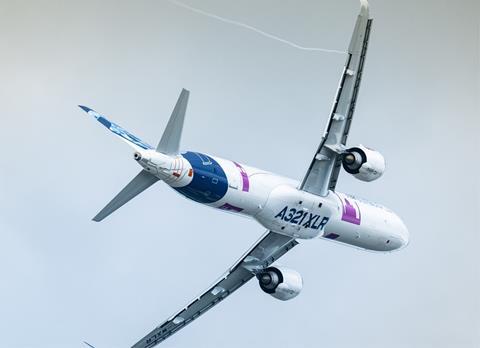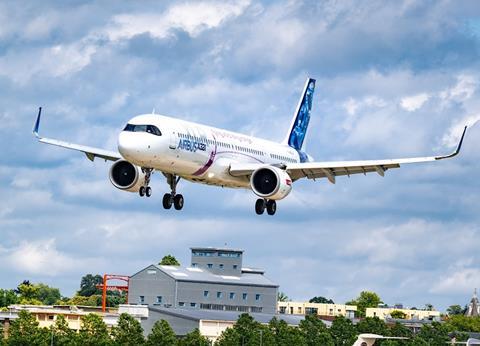Airbus is looking to obtain higher-weight certifications for its A321XLR over the next three months, as it works on the individual enhancements required by early operators of the long-range twinjet.
The airframer secured European Union Aviation Safety Agency approval for the basic version – with a 97t maximum take-off weight – on 18 July.
A321XLR programme head Gary O’Donnell tells FlightGlobal that the initial certification covers “all the required topics which make an XLR an XLR”, including its large rear centre fuel tank, reconfigured fuel-supply pipes, aerodynamic revisions, and the structural changes to support an eventual MTOW of 101t.
“Then we have two-and-a-half to three months’ worth of activity…during this time we certify all the weight variants, the different steps,” he says, adding that a similar process was undertaken for previous A321neo models including the A321LR.
“We’ll do all modifications specifically for the customer options – whatever the first customer takes, then the second customer, third – plus do all the extra topics for the fully-functioning XLR, like the autoland and the additional [forward] auxiliary centre tank.”

The initial certification covers the XLR fitted with CFM International Leap-1A powerplants, used on earlier A321neos.
“That was very important to us, that we build an aircraft that can perform with same engine,” says O’Donnell. “There’s a certification activity which has already completed last month, and we needed that in order to certify the [XLR]. CFM has done that already.
“If a customer has specific option with CFM, that will get certified in next two-and-a-half to months – like weight variant, engine ratings, all of those things come to build the full option package for the airlines in front of us.
“We don’t change the aircraft at all. The aircraft we have sitting in our [final assembly line] today is finished.”
CFM partner Safran confirms to FlightGlobal that “all the Leap-1A thrust ratings” – up to 35,000lb (156kN) – have been certified by EASA, adding that they are “available through a software update, without design change”.
Airbus expects certification of the Pratt & Whitney PW1100G-equipped version later this year.
Iberia will be the first XLR operator and O’Donnell says Airbus is “shooting for the end of September, into the start of October” for handing over the initial aircraft to the Spanish carrier, depending on the pace at which EASA releases documents.

Although the rear centre tank, which replaces four auxiliary tanks, was originally conceived for the A340-500, O’Donnell says: “Applying it to a single-aisle is new.”
The tank is situated between the main landing-gear bay and the aft cargo hold.
Securing approval for the tank has required close collaboration with EASA, he adds, not least because crashworthiness requirements were upgraded part-way through the XLR development programme. These demand the aircraft can safely belly-land – without engines and landing-gear support – and slide without the risk of tank rupture if the fuselage skin is torn open by an obstacle.
The 13,000-litre tank’s lower wall is the fuselage underside, while its interior features floor-to-ceiling vertical reinforcements. Two fuel pumps at the back transfer fuel to the centre wing-box tank, and there are vertical tubes in the middle of the tank to provide fuel-quantity information to the crew.
Its shape is designed to fit around structures including evacuation-slide housing for passenger exits behind the wing, and has upper curved sections to make room for external air-conditioning and other systems which need to run past the tank – making the architecture complex, and adding to the difficulty of demonstrating crashworthiness.
The tank-rupture risk is managed through a tough liner. O’Donnell indicates it is based on silicon and aromatic polyamide, or aramid, fibres which are heat-resistant and used for body armour, and will prevent high-volume spillage and the possibility of a pool-fed fuel fire blocking exits.
Airbus extended the belly fairing on the XLR by 1.5m, taking it closer to a rear antenna, to provide additional tank protection and creating a barrier to heat transfer. The tank also has inerting systems.
The modified fuel lines include piping along the right wing which will serve as a venting channel for air inside the tank, enabling fuel to be uplifted quickly during the short turnaround times typically experienced in single-aisle operations.

With the XLR intended for a MTOW of 101t, the landing-gear has been upgraded. The main gear is entirely new, and simplified to feature a single-stage oleo in contrast with the previous double-stage design, while the nose-gear is a reinforced version of the existing assembly. The aircraft’s higher weight also required new wheel, tyres and brakes.
Airbus expects to transfer some of the enhancements back to earlier A321 variants.
Developing the XLR has involved strengthening some 80% of the airframe, largely through increased thickness, to absorb additional loads.
The XLR has a simplified inboard flap, replacing the prior double-slotted mechanism, and the airframer has worked to refine flight-control software in order to maintain performance.
It also hosts the electronically-driven ‘E-rudder’, which replaces mechanical interfaces and physical cables – which would be obstructed by the rear centre tank – with a lighter electric architecture. The system is already installed on widebodies including the A350.
As the XLR is designed to operate over longer ranges, additional consideration has been given to noise and thermal comfort for passengers. The aircraft has three heated zones, rather than two, and heated floor panels are fitted at each door for the crew.
It retains the current A321 water tank but adds the forward water tank from corporate jet variants, to provide 400 litres of potable water, the pipes from which have heating elements to prevent freezing during long-duration flights. The XLR also has a 220-litre waste tank with an option for 300 litres.
Airbus has a number of US customers for the XLR. O’Donnell says US FAA certification is likely “within a few months” of the EASA approval, adding: “We hope by the end of summer.”


























